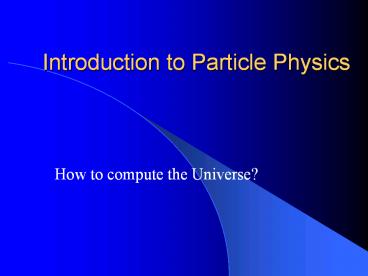Introduction%20to%20Particle%20Physics - PowerPoint PPT Presentation
Title:
Introduction%20to%20Particle%20Physics
Description:
So, how did we get from particles to galaxies? Brief history of the ... Matter-antimatter imbalance in the Universe. A.D. Sakharov. How to observe CP-violation? ... – PowerPoint PPT presentation
Number of Views:89
Avg rating:3.0/5.0
Title: Introduction%20to%20Particle%20Physics
1
Introduction to Particle Physics
- How to compute the Universe?
2
What do we study?
How did we get from here to here?
3
So, how did we get from particles to galaxies?
4
Brief history of the Universe
5
Thus, we have to understand what our world is
made of
6
What is the world made of?
- Fire
- Water
- Earth
- Air
- that is, according to the Greeks!
7
Modern understanding the onion picture
Nucleus
Lets see whats inside!
8
Modern understanding the onion picture
Lets see whats inside!
9
Modern understanding the onion picture
Mesons and baryons
Lets see whats inside!
10
Modern understanding the onion picture
Quarks and gluons
Lets see whats inside!
11
Modern understanding the onion picture
?
so the answer depends on the energy scale!
12
Aside units used in particle physics
Energy electron-volt 1 eV 1.6x10-19
J (energy that an electron gains going through
a potential difference of 1 Volt)
E mc2, so set c1! natural
units Mass electron-volt
proton mass mp 938.27 MeV Momentum electron-vo
lt
13
same thing about the interactions
- The answer depends on the energy scale.
14
Unification of forces
15
The Standard Model of Elementary Particle Physics
- Periodic table of matter
- Interactions electromagnetic, weak, strong,
(gravity) - Contains 26 parameters needs experimental
input
Higgs particle
16
(No Transcript)
17
Open questions
- Higgs particle is not (yet) discovered
- mechanism of electroweak symmetry breaking
- Standard Model does not have enough asymmetry
between particles and antiparticles to create the
Universe as we know it - CP-violation and baryonogenesis
- New Physics beyond the Standard Model?
- supersymmetry, strings, extra dimensions
18
Example What is CP(T)?
Classical mechanics is invariant under C,P, and T!
19
Classical Field Theory EM
Maxwells equations are invariant
under C,P, and T!
20
Why do we want to study CP-violation?
Matter-antimatter imbalance in the Universe
- Baryon (and lepton) number - violating processes
- to generate asymmetry
- Universe that evolves out of thermal equilibrium
- to keep asymmetry from being
washed out - Microscopic CP-violation
- to keep asymmetry from being
washed out
A.D. Sakharov
21
How to observe CP-violation?
- I. Intrinsic particle properties
- electric dipole moments
Low energy strong interaction effects might
complicate predictions!
22
II. Transitional particle properties
Low energy strong interaction effects complicate
predictions!
23
Why study B-physics?
B-factories are hunting for signs of
CP-violation in the decays of
B-mesons
- Possibility to control strong interactions
- controllable theoretical expansions
- New Physics sensitivity
- new physics contributions destroy SM relations
Example CKM unitarity
Vud Vub Vcd Vcb Vtd Vtb 0
24
Experimental methods
25
(No Transcript)
26
Experimental methods II
Theoretical predictions can be tested
experimentally!
- Threshold (e e-) B-factories (CLEO, BaBar,
Belle) - Hadronic (pp) machines (CDF, D0, B-Tev, LHCb)
- ep-machines (HERA at DESY)
27
Experimental Facilities
Cornell University
SLAC
28
Experimental Facilities II
KEK (Japan)
29
Experimental Facilities III
FermiLab (Batavia, IL)
30
Research in Particle Physics
- Theory
- Alexey Petrov
- William Rolnick
- Experiment
- Giovanni Bonvichini
- David Cinabro
- Robert Harr
- Paul Karchin
- Stephen Takach
as well as postdoctoral research associates and
graduate students
31
Conclusions?
- What the particle physics is
- Why we study particles
- How we study particles
- Further questions?
- Prof. Alexey A Petrov
- Physics Research, Rm. 260
- apetrov_at_physics.wayne.edu






























